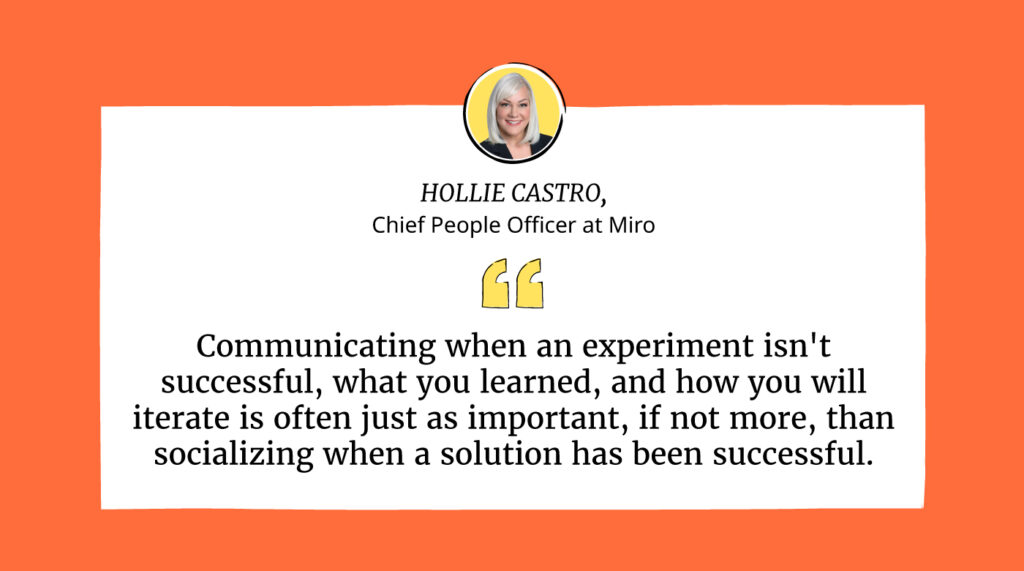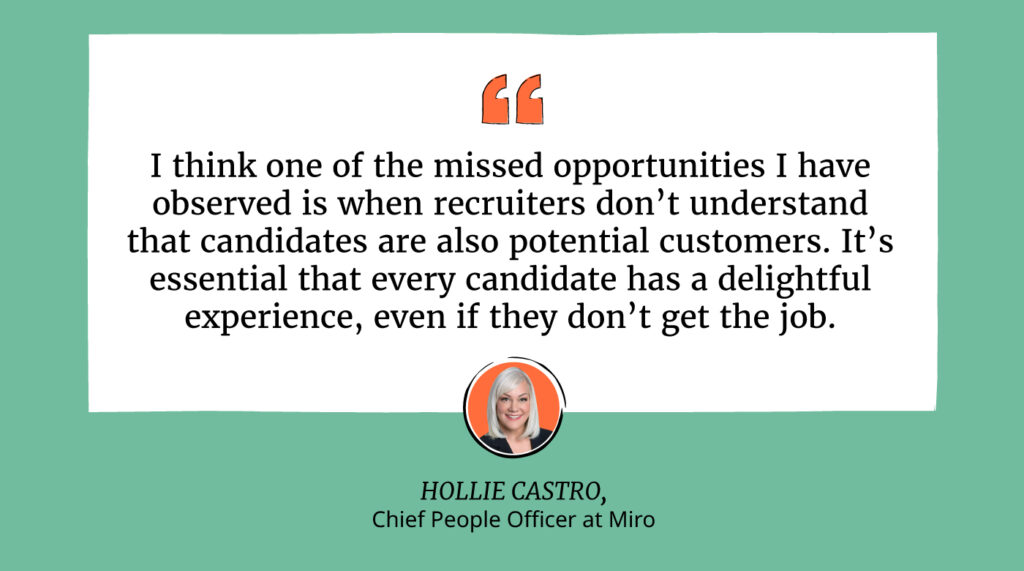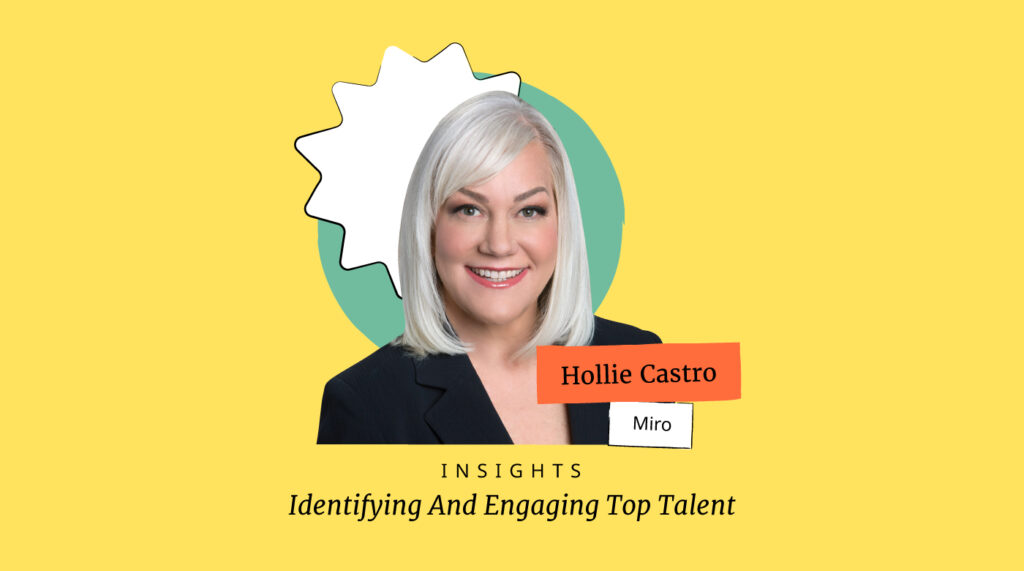Companies are always on the lookout for talented people. In this interview series, we talk to seasoned HR professionals to pick their brains for ideas and insights on finding the right talent for our organizations.
Thank you so much for joining us in this interview series! Before diving in, our readers would love to get to know you. Can you tell us the "backstory" about what brought you to this specific career path?
I started my career in sales and marketing, but, while getting my MBA, I discovered that I love business and the human dimension of business was what really piqued my interest.
More specifically, I love working with companies where humans are considered their most important asset. In these environments, people become the center of the business strategy. Over the course of my career, I’ve been fortunate to play a role in fostering such human-centric cultures at companies as diverse as Cisco, YETI, and, now, Miro.
The human condition is constantly evolving. Factors that didn't use to be influential are now reasons that people join and stay at companies—including employers’ commitment to sustainability, focus on well-being, and flexible return to work policies, to name a few.
In fact, Miro’s recent “The Ways We Work” survey shows that the option to work remotely replaced growth opportunities in the top three qualities workers look for in a dream job between pre-pandemic and today.
How the intersection between head and heart shifts over time in response to both macro and personal circumstances absolutely fascinating to me. For example, that same survey shows that workers from Generation X are more likely than their counterparts from other generations to value jobs that offer a high salary and the option to work remotely; their priorities reflect their life stage, as they’re often juggling work with taking care of kids, as well as parents.
There’s no proven formula for transforming workplaces to address these ever-changing factors. It takes a willingness to deeply listen to employees, experiment, and iterate—all acts that initially attracted me to a career in HR and keep me energized to this day.
It has been said that our mistakes can be our greatest teachers. Can you share a story about the funniest mistake you made when you first started? Then, can you tell us what lesson you learned from that?
In terms of how you’re remembered, how you resign and exit a position is more important than anything else you did at a company, so do it with grace. The notion that you're going to stay at a company for the rest of your life is long gone, but, when you dismount badly, it can be a career wrecker.
Earlier in my career, I didn't understand this. Simple things like giving ample notice, building a strong successor, and leaving a detailed work transition plan is paramount. Maybe the most important nuance that I had to learn is that leaving a company is not about you, it’s about the people you leave behind. Focusing your energy on leaving them in a positive position is key. The journey is long and the relationships that you build will serve you years later.
Can you please give us your favorite "Life Lesson Quote" and how that was relevant to you in your life?
“Our deepest fear is not that we are inadequate. Our deepest fear is that we are powerful beyond measure. It is our light, not our darkness that most frightens us. We ask ourselves, ‘Who am I to be brilliant, gorgeous, talented, fabulous?' Actually, who are you not to be?” Marianne Williamson
For most of my career I was the only woman in the room and many times I was the youngest person. This was very intimidating, and I often found myself questioning if I was good enough, smart enough, deserving enough. There was a key moment after I had my daughter when I realized that all of these doubts were in my head. The quote was something that lifted me up and inspired me to deeply explore my gifts and talents and lean into them.
Are you working on any exciting new projects at your company? How is this helping people?
Since I joined Miro in September, I’ve been on a listening tour, learning as much as I can, soaking in the culture, and witnessing the company’s values in action.
It’s been an amazing experience! One of Miro’s core values is iteration. I’ll be taking insights from my listening tour and using them to experiment and iterate on what’s working and what’s not working for employees in today's environment.
Along those lines, one of the most exciting things Miro is introducing is a new workplace design concept called “Living Lab,” which redefines what an office should be and includes space for nature, well-being, and meaningful interaction. It’s organized based on individuals’ and teams’ evolving needs and preferences.
How we work is fundamentally shifting. Hybrid teams are now commonplace. Employee expectations are evolving and workplace culture must evolve with it. While other companies are shuttering offices, Miro is investing in its Living Lab concept and opening up these new spaces in Amsterdam and Austin, to start.
Miro worked with Makers of Sustainable Spaces aka MOSS Amsterdam and NorNorm to create:
- A botanical sanctuary where 6-8% of the space features plants, anchored in research that 5-8% of space featuring nature leads to improved cognitive abilities
- Plants in stairwells attract more people to use the stairs (and move)
- Over half (60%) of the space is dedicated to collaboration, 40% for focused work
- A parents room for nursing
- A Tatami room which doubles as a meditative, restorative space and multi-faith haven
- A co-working cafe to gather for meals, happy hour and more
Sound amazing! Now let's jump into the main focus of our series. Hiring can be very time-consuming and challenging. Can you share with our readers a bit about your experience with identifying and hiring talent? What's been your most successful recruitment-related initiative so far?
There are a few things that come to mind, but definitely having a clear understanding of the values that ground your culture, as well as a strong balance between skills and competence to do the job and being additive to the company culture.
One of the things that I love about Miro is that we take a 360 view in our hiring process. This means we get input from employees, peers, and hiring managers on our interview panels. I am also a big believer in team interviews that feel inviting and engaging to a candidate.
Finally, really creating an individual experience for the candidate by building a relationship with them to understand their personal situation is key.
Once talent is engaged, what's your advice for creating a great candidate experience and ensuring the right people go through the process?
I generally believe that the earlier in the recruitment process you begin demonstrating and talking about values, the more likely candidates that share those values are to stand out in the process and pass through it.
At Miro, we put our values in every job description and our recruiters and hiring panels know that they should be prioritizing values alongside competency when screening and scoring candidates.
Often there is pressure to get a role filled quickly, but, in my experience, being tenacious and patient enough to hold out for the right candidate is mission-critical.

Based on your experience, how can HR and culture professionals work with the broader organization to identify talent needs?
I believe that there are two important elements to support the identification and advancement of organizational talent needs.
First, it’s critical that HR professionals deeply understand the business. I have heard many times that we are “people people,” but, in my mind, the best HR professionals are business people who happen to be experts in the discipline of people.
Understanding how your business makes money, who your competitors are, how the landscape is shifting, and the overall business strategy, allows HR professionals to bring invaluable insights to the table. Being able to anticipate what will be needed before it is asked is a trait I believe is present in truly strategic HR organizations. Using data to inform these insights is a powerful way to advance the talent agenda.
The second element that I believe is important is really listening to the organization on a frequent basis and, in turn, communicating how you are experimenting and designing solutions that serve their needs.
Communicating when an experiment isn't successful, what you learned, an how you will iterate is often just as important, if not more, than socializing when a solution has been successful.

Is there anything you see that recruiters, internal or otherwise, do regularly that makes you think, "No, stop doing that!"?
I think one of the missed opportunities I have observed is when recruiters don't understand that candidates are also potential customers. It's essential that every candidate has a delightful experience, even if they don't get the job.
What’s more, it’s important for recruiters to remember that top talent always has a choice. An interview is a two-way process, and selling the company and opportunity honestly is as important as vetting the candidate’s interests and skills.

With so much noise and competition out there, what are your top 3 ways to attract and engage the best talent in an industry when they haven't already reached out to you?
- Employer branding is important, and we try to amplify the stories about why Miro is a great place to work. That includes having a strategy for workplace awards and telling stories about the diversity in our organization. We also rely heavily on referrals, and you need a truly great workplace for people to consider inviting their friends to join the team.
- We have a strong user-to-employee pipeline, meaning that there are a lot of Miro users who are passionate about our product and are engaged in our community. We look for opportunities to bring these people onto our team, even if it means creating a role that’s custom-fit to their background. This pipeline is especially strong in our Customer Success organization, where our most passionate users join Miro and help some of our most valuable customers be successful with the product.
- Think ahead about the type of talent you will need in the future and build relationships with them even if you don't have a role today. It is every people manager's job to be a recruiter. We are all talent scouts and, regardless of your function, it is critical to think about your role through this lens.
It is every people manager's job to be a recruiter. We are all talent scouts and, regardless of your function, it is critical to think about your role through this lens.
What are the three most effective strategies you use to retain employees?
- Listen, learn, and respond. Hybrid and remote work can make it more difficult to know how someone is really feeling or how someone is really doing. So as leaders and managers, we have to completely rethink how we engage, how we check in, how we listen, how we communicate, and how we stay in tune with the happiness and engagement of our teams. Now more than ever, people want to be seen, heard, and recognized. Leaders and companies that really listen and respond to employees’ needs will retain top talent.
- Create strategies that honor individuals’ new ways of working. There's a shift going on in the workplace. When I was growing up, you stood out by being the first one in the office in the morning and the last one out at night. But now, employees strive to stand out through work quality and impact, while integrating their work and life in a way that works for them.
The organizations that become known as great workplaces for the next generation of talent will be the ones that enable high-quality work and, in doing so, cultivate employees’ pride and sense of ownership. And they’ll do so while allowing their talent the space and time for rich lives outside of work to pursue their own interests, whether those are side hustles, hobbies, or spending time with family and friends.
- Continue to set the bar high and reward leaders at every level. Treat people with respect and reward results. In “The Ways We Work” survey, of the 850 knowledge workers who said their relationships with their managers have improved in recent years, 40% pointed to their manager encouraging their growth and giving them new challenges as the top reason. Sometimes growth opportunities mean moving up and taking on more responsibility. Sometimes it is a lateral move to broaden your skills and better position you for future opportunities. Employers that focus on professional development will win, creating a more inclusive workforce where all employees’ talents are encouraged and skills developed.
Here is the main question of our interview. Can you share five techniques that you use to identify the talent that would be best suited for the job you want to fill? Please share an example for each idea.
1 . Curiosity is a critical characteristic. I love to ask questions that help me explore how their minds work. Curiosity is a trait that is teachable when children are growing, but it's also something people are born with as part of their DNA. It is harder to teach adults to be curious.
2 . Learner's mindset. I like to explore a time when someone failed, which isn't the point of the question. The point, for me, is that our best learnings tend to come from our failures. How self-reflective are they? How did they change their approach based on their learnings? How do they share learnings with others? Learner’s mindset and curiosity go hand and hand.
3 . Agility and adaptability. In today’s world, the ability to adapt and be agile is the name of the game. One thing that is certain is change. I like to ask questions that lead me to discover how rigid someone is or isn’t. How adventurous are they? Do they take calculated risks and do those types of risks align with our culture?
4 . Resiliency. I like to explore a time when things were tough to get a sense of their resilience. What did they do? What structures did they lean on to guide them through? How did they approach it and what did they learn? How they approach small challenges that are thrown at them now may offer insight into how they will lead when times are difficult down the road, during the peak of their leadership years.
5 . Vulnerability. The best leaders I know are the ones who are willing to share their vulnerabilities and failures, ask for help and “be human.” Especially when interviewing people leaders, I love to explore how they do or do not do this. How do they create connections with their teams to allow for people to share their vulnerabilities back?
Is there a person in the world whom you would love to have a private lunch with and why?
Condoleezza Rice comes to mind. She’s an incredible leader and has had to navigate so many difficult situations with potentially disastrous consequences. She has overcome some of the most difficult barriers. She also has many diverse interests and seems incredibly interesting. I would be fascinated to get to know her and learn from her!
Thanks Hollie! Some incredible insights in there. How can our readers continue to follow your work?
I encourage your readers to check out the MiroBlog, where we share Miro’s unique perspective on workplace trends, product updates and tips for how to be successful on Miro.
More from the series:

